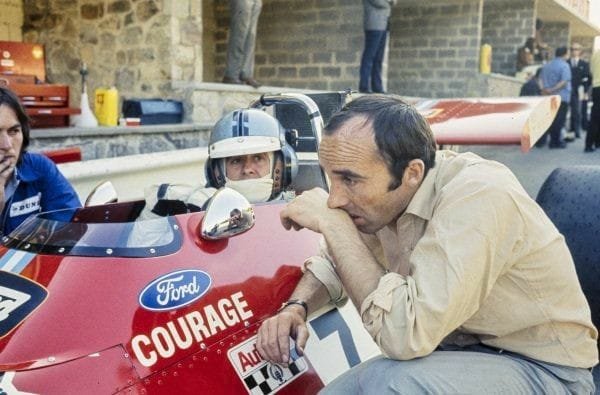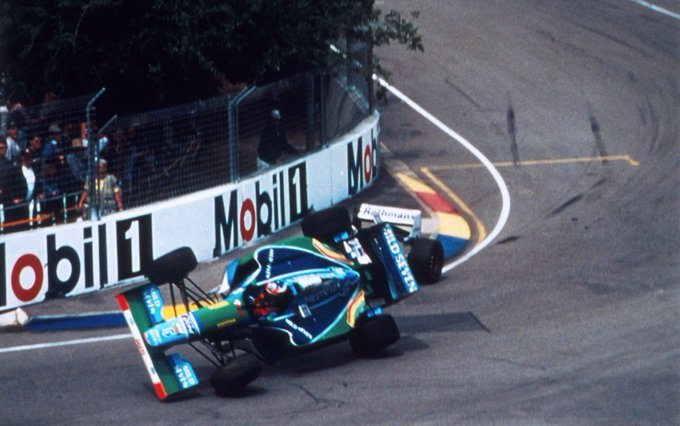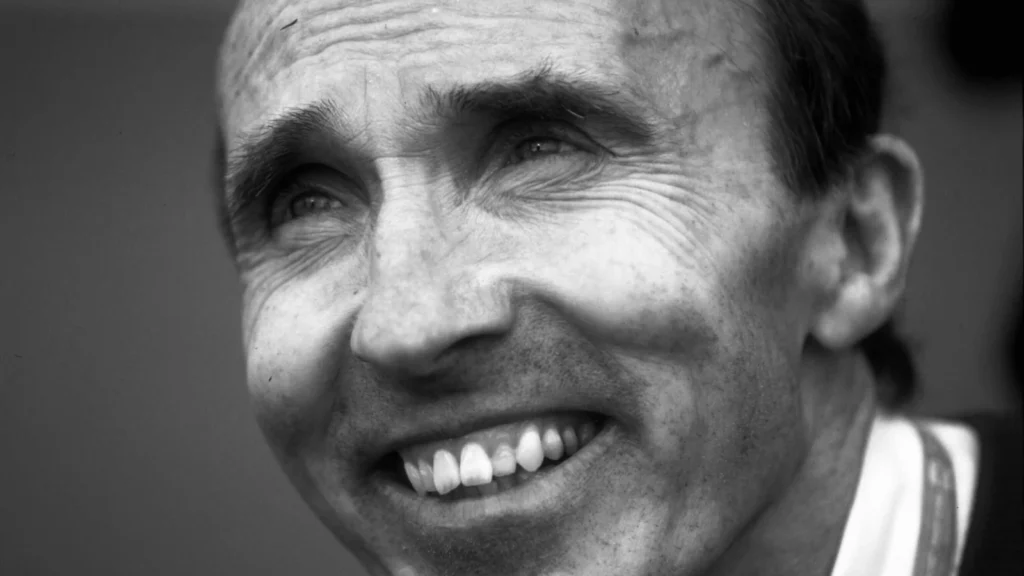F1 was reminded this week of one of racing’s greatest heroes. Sir Frank Williams. He would have turned 83 years old.
Early Life and Beginning in Racing
Frank had a relatively modest upbringing: his dad was in the RAF during WW2 and his mother was a school teacher. Unlike Enzo Ferrari, Frank wasn’t a naturally gifted driver and unlike Ron Tauranac he wasn’t a mechanical genius.
Instead, Frank’s strength was his salesmanship. He could raise money from a stone. He could attract sponsorships greater than any other.
His background was in groceries, using his money from being a salesman to reinvest in motorsport. He met Piers Courage in the mid-1960s and the duo became friends. They made a combined Formula One effort after purchasing a Brabham chassis in 1969. The team name: Frank Williams Racing Cars.
Brabham had a very quick car in 1969. Jacky Ickx won races and Jack Brabham took podiums in that car and it was the second-best car on the grid that season.

In Courage’s hands, his privateer Brabham scored two podiums that season, which impressed ex-driver Alejandro de Tomaso who decided to build a car for Williams so they were a factory team. Tragically, Courage died at the 1970 Dutch Grand Prix.
Frank Williams was devastated at the loss of his friend and from this point onwards he tried to distance himself from his drivers.
The Fall of Frank Williams Racing Cars
The de Tomaso partnership didn’t go to plan and after two years with March where they scored the odd point, Williams began designing their own cars instead of buying chassis designed by other teams from 1973.
The car was a solid midfield runner, but they had so many drivers over the season as Frank Williams needed money to help him fund the team.
Overall, Howden Ganley had a full-time seat alongside a revolving door of other drivers such as Nanni Galli, Jackie Pretorius, Henri Pescarolo, Tom Belso, Graham McRae, Gijs van Lennep, Tim Schenken and Ickx.
He managed to get Iso and Marlboro sponsorship, which showed Williams’ talent for attracting sponsors, which further helped backing. As well as this, Williams also had a knack for saving money as after he couldn’t pay bills, he conducted business calls from telephone boxes, showing he would do whatever it took to find success.
Around this time he married his wife Virginia or “Ginny.” They would have three children. Two boys called Jonathan and Jaime and a daughter called Claire.
1974 was a similar story, although it was Arturo Merzario in the full-time seat alongside Richard Robarts, Belso, van Lennep and eventually Jacques Laffite, who was the second driver for the final five races of 1974.
Selling to Walter Wolf
The money began to dry up however and despite a podium with Laffite in the 1975 German Grand Prix and numerous pay drivers who replaced Merzario, Williams had to sell 60% of the team to Walter Wolf.
After going through several designers such as Len Bailey and John Clarke, a youngster called Patrick Head became the lead designer. When Wolf took over, however, Harvey Postlethwaite was chosen to lead the team to design the car. After a year with Wolf-Williams, Frank was replaced as team manager by Peter Warr and he sold his 40% stake to Wolf.
Williams went to Head and asked if he wanted to join him on a potential partnership, The modern Williams we all know was now founded.
Wolf had renamed Wolf-Williams Racing to Walter Wolf Racing. Initially, they had a lot of success with Jody Scheckter and it seemed that he had made the correct call in removing Williams, but history would prove his decision wrong as by 1980, Wolf was no longer a team.
The Beginning of Williams Racing
Basing themselves in a small carpet warehouse, Head and Williams began on a shoestring budget with a March 761 with Patrick Neve in 1977. Although initial success didn’t come, Frank managed to get sponsorship from Saudi Airlines and TAG meaning Williams and Head had the money to design a proper car. Despite this, they used radiators from a VW Golf and a regular Hewland gearbox according to Neil Oatley.
Although reliability was initially an issue, Williams and Head along with driver Alan Jones, took a maiden podium in the US Grand Prix of 1978.
In 1979, Head designed the FW07 with Oatley and Frank Dernie. This trio would design the FW07, FW08 and FW09 until Oatley left, and the success was incredible. The FW07 was now being driven by two Grand Prix drivers in Clay Regazzoni and Jones, and with Dernie’s knowledge of ground effect, Williams was quickly a frontrunning team. It was such a good car that out of the four chassis made, three of them won Grand Prix.
Five wins came with the FW07, with one victory for Regazzoni being the last bookmark in his long career and the first in Williams’ long history at the British Grand Prix. Jones won four races and had Williams had a better opening half of the season, they could have been title contenders.
Maiden Titles
Regazzoni was replaced by Carlos Reutemann for 1980. Reutemann and Jones were a brilliant partnership in 1980. Jones won five Grand Prix in the FW07B/7 and FW07B/9 en route to his only world championship and the first constructors’ title for Williams. Reutemann won in Monaco and finished third in the standings.
Over the next two years with Williams, Head, Dernie, Oatley, a Ford-Cosworth engine and Reutemann, Jones and later Keke Rosberg, Derek Daly and Mario Andretti, Williams won a constructors championship and a drivers championship with Rosberg along with five Grand Prix victories.
The rise of the turbocharged engines meant the chassis took a few years to get a hang of and from 1985, their title sponsor was now Canon rather than TAG or Saudi Airlines.
The Accident and Recovery
Finally, Williams and his team had gotten a handle on the turbocharged era with Honda engines. The FW11 was a brilliant car. Williams and team sponsorship manager Peter Windsor were driving back from a test session at Paul Ricard with the FW11 when he suffered a crash.
While Windsor wasn’t badly injured, Williams was. Windsor got emergency services on the scene and Ginny Williams and Head went to France. Ginny thought Frank was going to die.
Ginny, Frank, Peter and Patrick went to London and Frank’s life was saved. Originally Frank was meant to be doing a half marathon as he was a keen runner, but he would never run again. He remained in a wheelchair for the rest of his life and was a tetraplegic, but Williams’ success would continue.
Dernie and Head were now the leaders at the track until Williams recovered. They had two incredible drivers Nigel Mansell and Nelson Piquet, but they did not like each other. Numerous spats and a tyre failure for Mansell in the finale meant Alain Prost from McLaren won the drivers’ but Williams won the constructors’.
1987 was dominant, as Honda, the drivers and the FW11, combined with Frank returning to the track was a fantastic combination. Williams won their third drivers’ championship and their fourth constructors’.
Issues with Honda meant they used a Judd engine for 1988 which went poorly. A move to Renault power followed, but Honda dominated with McLaren until 1992 when the stars aligned.
Prime Williams
Adrian Newey, Dernie, Paddy Lowe and Head were running the aerodynamic aspect of the team, and the creation of active suspension meant Williams dominated 1992 with Mansell and Riccardo Patrese with the FW14 and 1993 with Prost and Damon Hill with the FW15.
After Prost retired, Ayrton Senna was signed by Frank Williams to partner Hill. Despite two poles in the opening two races, Senna had no points. They also signed with Rothmans to replace Canon.
Then the tragic San Marino Grand Prix happened, where Senna passed away after an accident. Newey, Williams and Head were accused of manslaughter along with three others, but eventually, all were cleared of charges.
Test driver David Coulthard and Mansell rotated the second seat while Hill was the number one. Hill, Newey and Head improved the car and it won the constructors, but Hill controversially collided with rival Michael Schumacher in Australia.

After a poorer 1995 with the FW17, the following two cars, the FW18 driven by Hill and Jacques Villeneuve, and the FW19 driven by Villeneuve and Heinz-Harald Frentzen, won back-to-back titles. Around this time they moved from Didcot to Grove, as the team was now too big for the location the team were founded in. In 1999, Williams was given a knighthood for ‘Services to the Motorsport Industry.’
Williams Struggles and the end of the Williams Family’s Involvement
The downfall began around this time. The rising costs of Formula One, the movement of Head in 2004 to Director of Engineering and the departure of Newey for McLaren was a disastrous combination. Despite wins with the likes of Ralf Schumacher, Juan Pablo Montoya and Pastor Maldonado, Williams did not win another title.
In 2012, Frank relinquished control of the team to Claire, his daughter, but he remained Team Principal until 2020 when Williams was sold to Dorilton Capital due to immense financial difficulties at Williams. In 2013, Ginny died after almost three years of battling with cancer.
Sir Frank Williams passed away on the 28th of November 2021 aged 79. Under his leadership, Williams won nine constructors’ titles, seven drivers’ titles, 114 Grand Prix, scored 312 podiums, 128 pole positions, 133 fastest laps, 33 1-2 finishes and had 28 Grand Prix winners, 11 world champions and 32 podium finishers drive for Williams.
RIP Sir Frank, we miss you.



